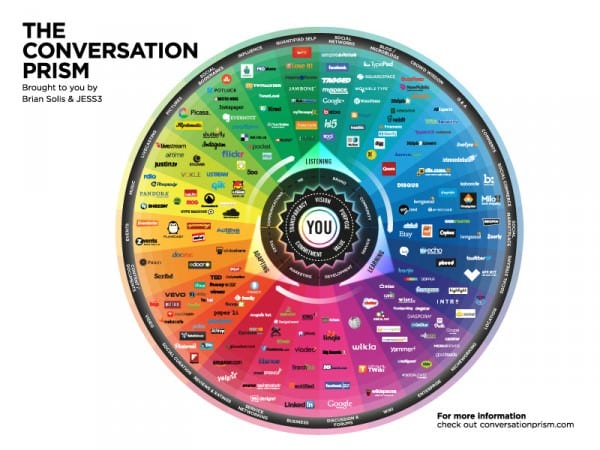Does the Conversation Prism help or hinder understanding of how to manage social media?
You might have seen the Conversation Prism has recently been updated to version 4 by Brian Solis? It’s always been a very useful reference to me - if only to help realise the potential of social media marketing, and the opportunity beyond that of Facebook and Twitter, the platforms that dominate social media plans.

Is it useful or confusing?
I read this post where the author, Richard Stacy, implies that graphics such as the Conversation Prism add to the confusion somehow. Stacy’s argument is a great insight that social media is an opportunity to evolve your marketing away from ‘channel and message’ (traditional media) and instead to a ‘behaviour identification and response’.
Stacy identifies 4 simple options for how a brand can be mentioned in social media:
- People saying nice things about your business
- People complaining about your business
- People asking questions for which your business provides an answer
- People indicating a willingness to help you make your business better
Do you agree? I concur with Stacy’s thinking, but I think it depends how you want to use the information in the diagram as to whether the diagram’s useful. I feel that Stacy’s expectation that the Solis model should relate to social media process, which is not what it’s for, is a little unfair. I see the prism as adding a strategic value at planning stage. In fact I feel inspired by the potential it presents, not blinded by the possibility. I’d agree that elements at the centre of the prism though might be pretty confusing.
Smart Insights developed the Social Radar in relation to other outreach and engagement models. In terms of process we created our inbound model as the start point for contextualising the outreach activity.
The Conversation Prism offers a planning value
The update to the graphic is strategically beneficial, I feel. Solis has sought to overlay a simple categorisation which is so useful for marketers at a planning stage - those categories, around the outside, including Q&A, events, crowd sourcing and curation. This is its value - it helps to ask better questions of social media. The inner ring helps at a strategic level - sales, brand and marketing, for example.
Of course some will pick holes in the accuracy - it’s not about that - it’s about the planning questions that are enabled. I’d also suspect that there will be niche communities available in your topic area and your market. Your starting point is actually more vast than the conversation prism communicates, but asking the simple questions, starting with Stacy’s above, is a great starting point.
I’d suggest standing in front of a big projection or print out of the new Conversation Prism and imagining the potential. What questions does it inspire you or your team to ask about what you’re seeking to achieve?






